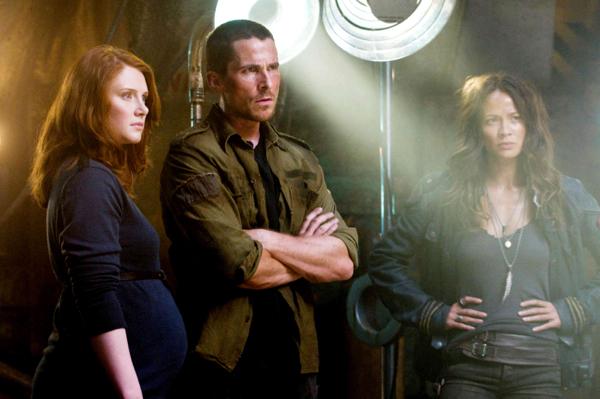Movie review by Greg Carlson
Sequels in lumbering, decades-old franchises slavishly obey the law of diminishing returns, and “Terminator Salvation,” the fourth feature in the series launched twenty-five years ago this October by James Cameron, is no exception. Painted in the dusty, dirty hues of gun-metal gray, McG’s addition to the venerable sci-fi/action behemoth takes itself far too seriously for audiences to have much fun, and the director’s vision is abetted by the humorless performance of Christian Bale, still switched deep into growling Batman mode. Bale’s John Connor is fundamentally less interesting than the Edward Furlong or Nick Stahl versions of the character, who at least behaved like human beings with feelings and emotions. The Connor of “Terminator Salvation” is the so-called “prophesized leader of the resistance,” and he believes his own messianic hype.
The time travel aspect of the “Terminator” movies has simultaneously been one of the storyline’s geeky intrigues and one of its central liabilities. Once salty, seasoned Connor meets his awkward and much younger father Kyle Reese (Anton Yelchin) face to face, “Terminator Salvation” has bigger problems than the space-time continuum. And while it is hard to imagine the slight Yelchin morphing into Michael Biehn, the young actor provides much of the movie’s limited comic relief. Partnered with an adorable, resourceful mute urchin cloned from Newt in “Aliens,” Yelchin turns out to be the one actor in “Terminator Salvation” who manages the self-aware wink at the audience that gave the Schwarzenegger entries so much of their appeal.
Directorially speaking, McG propels the action forward in a workmanlike facsimile of a video game. McG’s “Charlie’s Angels” films were like gumball machines bursting with candy coated pop culture references from sources as disparate as “Singin’ in the Rain,” “Flashdance” and “The Matrix,” not to mention “The Terminator” and several other Schwarzenegger movies. This time out, the swaggering filmmaker drains all the color from the screen, even though he retains several of his longstanding cinematic crushes via visual homage, most notably “The Great Escape.” McG’s nods to worthier film culture don’t really help his case, but they do offer movie buffs something to spot in between the carnage and mayhem.
Bale isn’t done any favors by being paired with Sam Worthington, who, along with a creepy, nude CG avatar of a youthful Arnold, turns out to be the movie’s real surprise. It only makes sense that Worthington’s soulful cyborg has more heart and humanity than the glowering Connor, since the robots are the very center of the Terminator universe. Needless to say, McG does not skimp on the machinery, and there are all kinds of new Skynet-spawned killers, from Transformer-esque T-1 and Harvester giants to snapping, snakelike horrors called Hydrobots. The humanoid T-600, T-700, and T-800 models wield machine guns along with their relentless drive to snuff out human life, but why some of them choose to wear grungy headbands is a mystery. Who knew that soulless, mechanical murderers developed a fashion sense when they attained sentience?
“Terminator Salvation” relies too often on the laziest action movie clichés: when faced with certain annihilation, the very thing needed to stop the marauding machine is miraculously, conveniently available. Along with recycled measures for halting Terminators, some of the signature lines of the cycle, including both “Come with me if you want to live” and the less welcome “I’ll be back,” are interjected presumably to remind audience members that they are watching another chapter in the Terminator saga. Those oft-imitated phrases, along with the teasing visage of the sitting governor of California, will remind many, however, that it is difficult to make a Terminator movie without Arnold.
